Introduction
The culinary landscape of Canada is like a rich tapestry woven with threads of diverse cultures, traditions, and flavors. When you think of Canadian food, you might instantly conjure up images of maple syrup drizzling over fluffy pancakes. While maple syrup is undoubtedly a Canadian cuisine treasure, the country’s cuisine goes far beyond this iconic sweet treat.
In this gastronomic exploration, we’ll take you on a mouthwatering journey through the best Canadian food you absolutely need to try. From the French-inspired delights of Quebec to the seafood-rich coasts of the Maritimes and the hearty, indigenous dishes of the prairies, Canada’s culinary scene is as vast and varied as its breathtaking landscapes. So, put on your culinary adventurer’s hat and get ready to embark on a delicious tour of Canada’s most delectable dishes.
Poutine: Canada’s Irresistible Comfort Food

Ah, poutine! This iconic Canadian food is the epitome of comfort food. Picture this: a generous serving of crispy, golden fries smothered in velvety cheese curds and drenched in rich, savory gravy. It’s a symphony of flavors that’ll have your taste buds dancing with delight.
The Origins of Poutine

The history of poutine is as rich as its flavors. Legend has it that this dish was born in rural Quebec in the late 1950s when a diner asked for a side of cheese curds to add to his fries. The resulting creation was an instant hit, and poutine quickly became a beloved Canadian classic.
Where to Find the Crispiest Fries and Best Cheese Curds

When it comes to poutine, not all versions are created equal. In your quest for the perfect poutine, you’ll want to seek out the eateries known for their crispy fries and top-quality cheese curds. Local diners and food trucks often serve some of the best poutine in town, but don’t be surprised if you find gourmet twists on this classic dish at upscale restaurants as well.
DIY Poutine: Creating a Taste of Canada at Home

Can’t make it to Canada but craving a taste of poutine? The good news is you can recreate this Canada food in your own kitchen. With a bag of frozen fries, authentic cheese curds, and a homemade gravy recipe, you’ll be well on your way to enjoying poutine without leaving home.
As you embark on your poutine-making adventure, remember that the key to a perfect poutine lies in the balance of textures and flavors. The fries should be crispy, the cheese curds should squeak when you bite into them, and the gravy should be piping hot. It’s a culinary experience like no other.
So, whether you’re indulging in this Canadian classic at a local diner, seeking out gourmet variations, or trying your hand at making it from scratch, poutine is a must-try Canadian cuisine that will satisfy your cravings for comfort food with a Canadian twist.
Bannock: A Taste of Indigenous Culture

Now, let’s delve into the intriguing history and cultural significance of a Canadian gem – bannock. It’s a culinary marvel that not only tantalizes the taste buds but also provides a window into Canada’s Indigenous cultures.
Unveiling the History and Significance of Bannock in Canada

Picture this: a simple, yet incredibly versatile bread that has been nourishing the souls of Indigenous peoples in Canada for generations. Bannock is a testament to the resourcefulness of Indigenous communities, adapted to the ingredients available in their respective regions.
Historically, bannock was prepared over an open fire, using a mix of flour, water, and sometimes added ingredients like berries or nuts. The dough was shaped into patties or sticks and cooked on a hot stone or griddle. It served as a staple food, offering sustenance during long journeys and harsh winters.
Today, bannock remains a symbol of resilience and connection to Indigenous traditions. Its popularity has spread far beyond Indigenous communities, making it a beloved part of Canada’s culinary tapestry.
Savoring Bannock in Indigenous-Owned Eateries

To truly experience the heart and soul of bannock, consider visiting Indigenous-owned eateries across Canada. These establishments not only serve mouthwatering bannock but also offer a cultural immersion that goes beyond the plate.
In the heart of Vancouver, you’ll find “Salmon n’ Bannock,” a restaurant that combines the flavors of Indigenous cuisine with a modern twist. Their bannock is a must-try, and you can savor it with a side of Indigenous-inspired dishes that showcase the diverse culinary traditions of Canada’s First Nations.
In Alberta, “The Bannock House” in Calgary offers a warm and welcoming atmosphere where you can indulge in bannock in various forms – from traditional to innovative. It’s a delightful journey for your taste buds and a chance to connect with Indigenous culture.
Bannock Recipes for a Homemade Indigenous Experience

If you’re feeling adventurous in your own kitchen, why not try your hand at making bannock from scratch? The beauty of bannock lies in its simplicity, making it accessible to home cooks of all skill levels.
To create your homemade Indigenous experience, start with a basic bannock recipe. Combine flour, baking powder, a pinch of salt, and water to form a soft dough. You can get creative by adding ingredients like dried fruits, wild berries, or herbs for extra flavor.
Once your dough is ready, shape it into patties or sticks and cook them in a skillet or on a griddle until they’re golden brown and crispy on the outside, yet soft and tender on the inside. The aroma of freshly baked bannock is simply irresistible.
Whether you choose to explore the history and cultural significance of bannock, savor it in Indigenous-owned eateries, or try your hand at making it at home, bannock offers a unique and delicious taste of Indigenous culture in Canada’s diverse culinary landscape.
Read – Foodie’s Guide to Asheville, NC
Butter Tarts: A Sweet Canadian Delight

If there’s one sweet treat that can make your taste buds sing the Canadian anthem, it’s the beloved butter tart. In this segment of our culinary journey through the diverse world of Canada cuisines, we’re diving deep into the world of butter tarts – a delectable pastry with roots firmly planted in Canadian soil.
The Allure of Butter Tarts and Their Canadian Roots

Let’s start with the basics: what exactly are butter tarts, and why do they hold such a special place in Canadian hearts? At first glance, they might appear as unassuming pastries, but one bite into a butter tart reveals their sweet secret.
A butter tart is a small, single-serving pastry filled with a gooey and rich butter, sugar, and egg filling. The magic happens when the tart bakes, and this sugary concoction caramelizes to perfection, creating a luscious, melt-in-your-mouth experience. It’s a taste that’s simultaneously sweet, buttery, and decadent.
As for their Canadian roots, the origins of butter tarts are the subject of some delightful debate. While their precise birthplace remains a mystery, it’s clear that butter tarts have been tantalizing Canadian taste buds for well over a century. They’ve become a staple at family gatherings, holiday celebrations, and local bakeries from coast to coast.
Locating the Finest Bakeries for Butter Tart Enthusiasts

Now that you’re undoubtedly craving a butter tart, where can you find the finest and most authentic versions? Well, Canada is dotted with bakeries that have perfected the art of making these sweet treasures.
In Ontario, the “Butter Tart Tour” takes enthusiasts on a delectable journey through the Kawarthas Northumberland region. You can visit various bakeries, each with its unique spin on the classic butter tart. From traditional to creative variations featuring pecans or raisins, this tour offers a delightful exploration of butter tart culture.
Meanwhile, in Quebec, the “Festival de la Tarte au Beurre” (Butter Tart Festival) in Saint-Liboire celebrates all things butter tart. It’s an annual event where local bakers showcase their finest creations, and visitors have the opportunity to taste and judge the best butter tarts in the region.
Perfecting the Art of Baking Butter Tarts Yourself

Of course, for those who love to bake, there’s nothing quite like the satisfaction of mastering the art of butter tart creation in your own kitchen. The good news is that making butter tarts from scratch is an attainable goal for home bakers of all skill levels.
Start with a classic butter tart recipe that includes the essential ingredients: butter, sugar, eggs, and a flaky pastry crust. Some recipes may also include additions like pecans or raisins, allowing you to experiment and find your perfect combination of flavors and textures.
The key to success lies in achieving that perfect balance between the sweetness of the filling and the flakiness of the crust. Remember, practice makes perfect, and even if your first batch isn’t flawless, it’s sure to be delicious.
So, whether you’re seeking out the finest butter tarts in local bakeries, attending butter tart festivals, or perfecting the art of baking them yourself, one thing is certain: butter tarts are a sweet Canada food that will keep you coming back for more, eh!
Nova Scotian Lobster Rolls: A Taste of Maritime Luxury

Hold onto your bibs, folks, because we’re about to embark on a maritime adventure that’ll have you dreaming of seaside feasts and ocean breezes. In this leg of our culinary journey through Canada cuisines, we’re diving into the world of Nova Scotian Lobster Rolls – a delectable treasure of Canada’s Maritime provinces.
A Maritime Adventure: Hunting for the Best Lobster Rolls

First things first, let’s set the scene. Nova Scotia, with its rugged coastline and pristine waters, is lobster paradise. Here, lobsters thrive in the cold, clean Atlantic Ocean, resulting in some of the world’s finest seafood. Now, imagine these succulent, sweet chunks of lobster meat tucked into a warm, buttery roll. That’s the magic of Nova Scotian Lobster Rolls.
When it comes to hunting for the best lobster rolls, you’re in for a delightful challenge. Along Nova Scotia’s coast, you’ll discover seafood shacks, lobster pounds, and waterfront restaurants that take lobster rolls to a whole new level. Each establishment boasts its unique spin on this maritime classic, making it a quest for the ultimate bite.
From Halifax to Peggy’s Cove and everywhere in between, locals and visitors alike flock to these coastal gems to savor the flavors of the sea. As you savor that first bite of a buttery lobster roll, you’ll understand why Nova Scotia is renowned for this maritime luxury.
Crafting the Ultimate Nova Scotian Lobster Roll in Your Kitchen

Now, let’s bring a taste of Nova Scotia’s coastline to your own kitchen. Crafting the ultimate Nova Scotian lobster roll is a delicious adventure that you can embark on anytime, anywhere.
Begin with the star of the show: lobster. Freshness is key, so if you’re not on Nova Scotia’s shores, seek out the freshest lobster available to you. Cook and shell the lobster, ensuring you have generous chunks of meat ready for your rolls.
Next, the roll. While traditional Nova Scotian lobster rolls use buttery, toasted hot dog buns, feel free to choose your favorite roll style – be it a classic split-top bun or a soft, pillowy brioche.
For the filling, keep it simple and let the lobster shine. Toss the lobster meat with a touch of mayonnaise and a sprinkle of chives, celery, or fresh dill for added flavor. A squeeze of lemon and a pinch of salt and pepper are the finishing touches.
Dive into Nova Scotia’s Lobster Culture

Beyond the delectable taste, lobster rolls are deeply intertwined with Nova Scotia’s lobster culture. Lobster fishing is not just an industry here; it’s a way of life. The lobster season, marked by ceremonial “first catches,” is a time of celebration, and lobster traps dot the coastal landscape.
Nova Scotians take pride in their sustainable lobster practices and the conservation efforts to ensure the lobster population thrives. So, when you savor a Nova Scotian Lobster Roll, you’re not just enjoying a delicious meal – you’re tasting the very essence of Maritime culture.
Whether you’re embarking on a culinary quest along the coastal towns of Nova Scotia or crafting your own lobster roll masterpiece at home, Nova Scotian Lobster Rolls are a taste of maritime luxury that embodies the essence of Canada’s coastal cuisine. So, grab a roll, pile on the lobster, and let the ocean flavors transport you to the rugged shores of the Maritimes.
Montreal-style Bagels vs. New York Bagels: The Ultimate Showdown

Hold onto your taste buds, folks, because we’re about to embark on a mouthwatering battle royale: Montreal-style bagels vs. New York bagels. This doughy feud has been simmering for decades, and today, we’re diving headfirst into the ring to settle the score and find out which bagel reigns supreme. So, roll up your sleeves and let the showdown begin!
Bagel Battle: Comparing Montreal and New York Styles

The stage is set, and the contenders are ready. In one corner, we have the Montreal-style bagel – smaller, denser, and boasting a distinctive chewiness. In the other corner, the New York bagel – larger, doughier, and with a hint of sweetness. Let the bagel brawl begin!
Montreal-Style Bagels: The Underdog with a Bite

Montreal-style bagels, often baked in wood-fired ovens, have an edge when it comes to texture. They’re boiled in honey-sweetened water before baking, creating a shiny, slightly sweet crust that packs a flavorful punch. These bagels are smaller in size, making them the perfect canvas for a variety of toppings, from classic sesame seeds to creative combinations like “everything” seasoning.
The Montreal bagel is a true underdog story. It may be smaller in stature, but it makes up for it with a chewy, satisfying bite that keeps bagel enthusiasts coming back for more.
New York Bagels: The Big Apple’s Doughy Delight

On the other side of the ring, we have the New York bagel, a heavyweight in the bagel world. These bagels are larger, softer, and have a distinct malty flavor that sets them apart. The New York bagel’s secret weapon is its versatility – they’re the perfect vessel for piling on cream cheese, lox, or deli meats.
One bite into a New York bagel, and you’re met with a delightful balance of textures – a crisp, golden crust giving way to a soft, chewy interior. It’s a bagel that knows how to make an entrance.
Where to Taste the Authentic Montreal Bagel Experience

If you’re on a quest to taste the authentic Montreal bagel experience, you’ll want to head straight to the source: Montreal itself. Stroll through the city’s charming neighborhoods, and you’ll find bagel shops that have been perfecting their craft for generations.
Fairmount Bagel and St-Viateur Bagel are two legendary institutions in Montreal, each with its fiercely loyal following. These shops have been churning out Montreal-style bagels for over a century, and a visit is like stepping back in time to savor a slice of history.
Secrets to Crafting Montreal-Style Bagels

But what if you’re not in Montreal and crave that Montreal-style bagel magic at home? Fear not; you can channel your inner bagel artisan and craft these delectable treats in your own kitchen.
The key to Montreal-style bagels lies in the dough. It’s a simple combination of high-gluten flour, water, yeast, salt, and a touch of honey. The dough is rolled into ropes, shaped into rings, and then boiled in honey-sweetened water before baking. This process ensures that glossy, sweet crust and chewy interior that defines Montreal bagels. As for toppings, sesame seeds are a classic choice, but you can get creative with poppy seeds, garlic, or even cinnamon sugar.
So, there you have it, the ultimate showdown between Montreal-style bagels and New York bagels. Whether you’re on #TeamMontreal or #TeamNewYork, one thing’s for sure – bagel lovers around the world can celebrate the rich diversity of Canada cuisines with every delightful bite. So, grab your favorite bagel, toast it to perfection, and savor the delicious results of this epic battle.
Read – Foodie’s Guide to Amsterdam
Saskatoon Berry Pie: A Taste of the Prairies

Hey there, pie enthusiasts and lovers of all things sweet and fruity, we’ve got a scrumptious Prairie delight lined up for you today – Saskatoon Berry Pie! This flaky, berry-packed masterpiece is a true Canadian food treasure that’ll have you dreaming of wide-open prairies and rustic charm.
Saskatchewan’s Treasure: The Story Behind Saskatoon Berries

First things first, let’s unravel the intriguing tale behind Saskatoon berries, the unsung heroes of the Canadian culinary scene. These tiny, deep-purple berries, often called “serviceberries,” have been nourishing Indigenous communities on the Prairies for centuries.
Legend has it that the name “Saskatoon” is derived from the Cree word “misâskwatômina,” which means “the fruit of the tree of many branches.” It’s a fitting name for a berry that grows abundantly on shrubs across the Prairie provinces.
The Saskatoon berry isn’t just a berry; it’s a cultural symbol deeply rooted in the traditions of the Plains Indigenous peoples. These berries were a vital part of their diet, used in various culinary creations and as a source of medicine. Today, Saskatoon berries continue to thrive in the Prairies, and their unique sweet-tart flavor is cherished by all who taste them.
Rustic Charm: Bakeries Serving the Best Saskatoon Berry Pie

Now that you’re well-acquainted with Saskatoon berries, it’s time to indulge in some berry pie action. If you find yourself on the Prairies, be sure to seek out bakeries that have mastered the art of Saskatoon berry pie.
Imagine stepping into a charming bakery, where the aroma of freshly baked pies fills the air. Bakeries like “Prairie Pies” in Saskatchewan or “Berry Barn” in Alberta are your go-to spots for a slice of Saskatoon berry pie heaven. These places know how to take those plump, juicy berries and turn them into a slice of pure Prairie nostalgia.
Baking a Mouthwatering Saskatoon Berry Pie From Scratch

Don’t fret if you’re not on the Prairies; you can bring the taste of the Prairies to your own kitchen. Baking a mouthwatering Saskatoon berry pie from scratch is easier than you might think.
Start by sourcing fresh or frozen Saskatoon berries, which are often available in well-stocked grocery stores or local markets. Prepare a flaky pie crust or, for added convenience, opt for a pre-made one.
The magic of Saskatoon berry pie lies in its simplicity. Toss the berries with sugar, a touch of lemon juice, and a sprinkle of flour to create a luscious, berry-packed filling. Pour it into your prepared pie crust, add a top crust, and don’t forget to cut a few decorative slits to let the steam escape.
As your pie bakes to golden perfection, your kitchen will be filled with the irresistible aroma of bubbling Saskatoon berries. It’s a scent that’ll transport you to the vast Prairies themselves.
So there you have it, the delightful journey of Saskatoon Berry Pie, a true taste of the Prairies and a cherished piece of Canadian food culture. Whether you’re savoring a slice at a rustic bakery or trying your hand at baking one from scratch, Saskatoon berry pie is a delicious tribute to the rich traditions of the Prairie provinces.
Montreal-style Smoked Meat: A Meat Lover’s Dream

Hold on to your taste buds, meat enthusiasts, because we’re about to dive deep into a carnivore’s delight – Montreal-style Smoked Meat! This mouthwatering Canadian food sensation is a meat lover’s dream come true, and we’re about to uncover the juicy secrets behind it.
Delving into Montreal’s Smoked Meat History
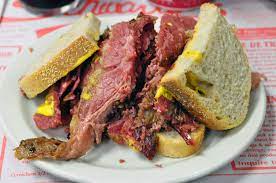
To truly appreciate the allure of Montreal-style smoked meat, let’s rewind the clock and delve into its flavorful history. This iconic Canadian food tradition has its roots in the late 19th century when Jewish immigrants brought their culinary traditions to Montreal.
Imagine a bustling Montreal deli, where stacks of succulent beef briskets are expertly cured with a secret blend of spices. The meat is then slowly smoked and steamed to tender perfection. What emerges is a flavorful masterpiece that has captured the hearts and appetites of Montrealers and visitors alike for generations.
The Ultimate Smoked Meat Sandwich Quest
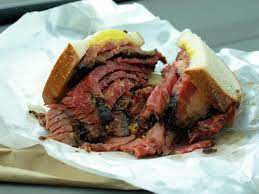
Now that we’re salivating over the history, it’s time for the ultimate quest: finding the perfect smoked meat sandwich in Montreal. The city is teeming with delis that have mastered the art of creating this meaty marvel.
One of the legendary establishments in Montreal is Schwartz’s Deli. Since 1928, Schwartz’s has been dishing out towering smoked meat sandwiches, each one a work of art. Picture it: tender slices of smoked meat piled high between slices of rye bread, accompanied by a dollop of mustard and a crispy pickle on the side. It’s a symphony of flavors that’ll have you humming with delight.
But Schwartz’s isn’t the only player in town. Lester’s Deli, the Main, and Reuben’s Deli all offer their take on the classic Montreal-style smoked meat sandwich. Each deli has its unique twist, from the thickness of the meat slices to the spice blend used for curing.
Mastering the Art of Making Montreal-style Smoked Meat

What if you’re not in Montreal but still craving the savory satisfaction of Montreal-style smoked meat? Fear not, because you can master the art of making it in your own kitchen.
Start with a high-quality beef brisket, as it’s the star of the show. The secret to that smoky, spicy flavor lies in the curing process. A blend of coriander, black peppercorns, and other spices is used to create the signature Montreal-style spice mix.
Once your meat is perfectly cured, it’s time for the smoking and steaming process. This slow, meticulous cooking method is what transforms an ordinary brisket into a melt-in-your-mouth masterpiece.
The result? Slices of smoked meat that are tender, juicy, and bursting with flavor. Serve them up in rye bread with a generous slather of mustard, and you’ve got a homemade Montreal-style smoked meat sandwich that’ll rival the best delis in town.
And there you have it, the delectable journey into Montreal-style Smoked Meat, a carnivore’s dream and a beloved part of Canadian food culture. Whether you’re indulging in a classic sandwich at one of Montreal’s iconic delis or mastering the art of making it at home, you’re in for a meaty delight that’ll leave your taste buds craving more.
Peameal Bacon: The Canadian Bacon
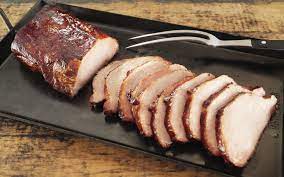
Alright, folks, if there’s one Canadian food item that deserves a special place on your plate, it’s peameal bacon. A culinary icon with Toronto origins, this succulent slab of meat is a true Canadian cuisine classic. Today, we’re taking you on a mouthwatering journey into the world of peameal bacon, from its historic roots to sizzling in the pan.
Peameal Bacon’s Toronto Origins and Canadian IdentityLet’s kick things off with a slice of history. Peameal bacon, also known as back bacon, originated right here in Toronto, Ontario. It’s a delicious piece of Canadian food heritage that dates back to the 19th century.
So, what’s the deal with the name “peameal”? Well, in the early days, the bacon was rolled in crushed yellow peas to help preserve it, giving it that distinctive “peameal” moniker. Over time, the peas were swapped out for cornmeal, which is what we see today.
Peameal bacon is made from pork loin, providing a lean and tender meat that’s brined and then rolled in cornmeal. The result? A juicy, flavorful bacon that’s loved across Canada and beyond.
Where to Find Top-Notch Peameal Bacon Sandwiches

Now, let’s talk about the best way to enjoy peameal bacon – in a sandwich! If you’re on a quest for the ultimate peameal bacon sandwich, look no further than Toronto. The city is peppered with eateries that specialize in crafting the perfect bacon-on-a-bun experience.
One legendary spot is the St. Lawrence Market, where you’ll find Carousel Bakery. Their peameal bacon sandwich is the stuff of legends – thick slices of peameal bacon, cooked to crispy perfection, and nestled between a soft bun. Top it with some mustard and maybe a pickle, and you’ve got a handheld masterpiece.
But Toronto isn’t the only place to get your peameal bacon fix. Across Canada, diners, cafes, and restaurants pay homage to this Canadian cuisine delicacy. So, wherever you roam in the Great White North, keep an eye out for the iconic peameal bacon sandwich.
Cooking Peameal Bacon Like a Seasoned Canadian Chef

Now, if you’re feeling adventurous in your own kitchen, you can try your hand at cooking peameal bacon like a true Canadian cuisine chef. It’s a straightforward process that doesn’t require culinary wizardry.
Start with a slab of peameal bacon, and here’s the secret: slice it thick. You want those generous, juicy portions. Heat up a skillet or frying pan and cook the bacon until it’s crispy on the outside and tender on the inside. Remember, peameal bacon doesn’t take long to cook, so keep a close eye on it.
Serve it up with classic Canadian breakfast staples like eggs and pancakes or, of course, in a sandwich. Don’t forget the maple syrup for that extra Canadian food touch!
And there you have it, the savory journey into peameal bacon, a Canadian food treasure that’s been delighting taste buds for generations. Whether you’re savoring it in Toronto, whipping it up at home, or enjoying it in a sandwich across foods in Canada, peameal bacon is a mouthwatering testament to the delicious diversity of Canadian cuisine.
Beavertails: Canada’s Iconic Fried Dough Treat
![]()
Well, if you’re in the mood for a truly Canadian food adventure, you’ve hit the jackpot with Beavertails. These whimsical, fried dough treats are not just a snack – they’re a symbol of Canadian cuisine culinary creativity and a must-try for anyone exploring Canadian cuisine. Get ready to dive into the delightful world of Beavertails, from their storied legacy to the art of making them yourself.
The Whimsical World of Beavertails and Their Canadian Legacy

Before we get into the delicious details, let’s talk about what makes Beavertails so special. Picture a slab of sweet, golden-brown dough stretched into the shape of a beaver’s tail – hence the name. This delightful creation is deep-fried until it’s crispy on the outside and irresistibly fluffy on the inside.
Now, the magic happens with the toppings. Beavertails are a canvas for all things sweet and savory. Whether you’re craving a classic dusting of cinnamon sugar, a drizzle of luscious chocolate, or a heap of gooey marshmallows, Beavertails cater to your every sugary whim.
The roots of Beavertails go back to Ottawa, where they were first served up by entrepreneurs Grant and Pam Hooker in the late 1970s. Since then, Beavertails have become synonymous with Canadian food, offering a warm, delicious escape on chilly winter days and a sweet treat for summertime adventures.
Exploring Beavertail Stands from Coast to Coast

Now that you’re itching to sink your teeth into a Beavertail, where can you find these delectable delights? The good news is that Beavertail stands can be found from coast to coast, making them a truly Canadian cuisine culinary experience.
Ottawa, as the birthplace of Beavertails, boasts a range of stands where you can savor the original treat. The iconic ByWard Market is a prime spot to indulge in this Canadian food favorite. As you stroll through the market’s vibrant atmosphere, you’ll likely catch a whiff of the irresistible aroma, leading you to a Beavertail stand.
But Beavertail stands aren’t limited to Ottawa. They’ve migrated across the country, popping up at festivals, fairs, and tourist hotspots. From Quebec to British Columbia, you can find Beavertails waiting to satisfy your sweet tooth.
Crafting Your Own Beavertails at Home

Now, for the adventurous foodies who want to try their hand at creating Beavertails at home, it’s entirely doable. You’ll need some basic ingredients like flour, yeast, sugar, and milk to create the dough. Then, it’s all about shaping, frying, and topping to your heart’s content.
One of the joys of making Beavertails at home is the opportunity to experiment with toppings. Get creative with fruit, nuts, and even savory options like bacon and cheese. Remember, Beavertails are all about indulging your taste buds, so there’s no wrong way to enjoy them.
And there you have it, the delightful world of Beavertails, a Canadian food sensation that’s as fun to eat as it is to say. Whether you’re indulging in a classic Beavertail from a stand or crafting your own sweet masterpiece at home, these fried dough treats capture the playful spirit of Canadian cuisine and are sure to leave you craving more.
Read- Foodie’s Guide to Austin, Texas
Split Pea Soup: A Hearty Canadian Classic
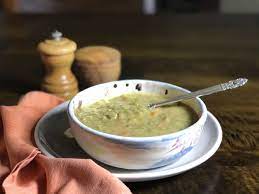
Ah, if you’ve ever yearned for a warm, hearty bowl of Canadian food comfort, you’re in for a treat with split pea soup. This dish isn’t just food; it’s a cozy, soul-warming embrace that embodies the essence of Canadian food culture. Today, we’re delving into the heartwarming world of split pea soup, from its universal appeal to the diverse regional twists that make it a Canadian cuisine classic.
A Warm Embrace: Understanding the Appeal of Split Pea Soup

First things first, let’s talk about what makes split pea soup so darn irresistible. Imagine a rich, velvety concoction that’s both comforting and nourishing. That’s split pea soup for you – a blend of dried peas, vegetables, and often, some form of savory meat. It’s a culinary hug for your taste buds.
The appeal of split pea soup goes beyond its taste. It’s a symbol of comfort, a reminder of cozy family gatherings, and the perfect remedy for chilly Canadian winters. A single spoonful can transport you back to your grandmother’s kitchen, where the aroma of simmering soup fills the air.
Family Recipes and Regional Variations from Across Canada

Now, here’s where split pea soup gets truly interesting – its regional variations. Across foods in Canada, from the east coast to the west, you’ll find families and communities putting their unique twist on this beloved classic.
In the Maritimes, for instance, split pea soup often features a generous helping of salted pork, lending a rich, savory flavor that’s characteristic of the region. It’s a taste of maritime tradition that’s been passed down through generations.
On the west coast, British Columbia showcases its culinary diversity by adding ingredients like smoked salmon or wild mushrooms to the mix. These variations highlight the influence of the Pacific Northwest and Indigenous flavors.
And in Quebec, a province known for its culinary prowess, split pea soup gets an upgrade with the addition of maple syrup, elevating the dish to a sweet and savory masterpiece.
Surviving Canadian Winters with a Bowl of Split Pea Soup

Now, let’s talk about the practical side of split pea soup – its ability to keep you warm and nourished during harsh Canadian winters. When the cold winds howl and snow blankets the landscape, there’s nothing quite like a steaming bowl of split pea soup to chase away the chill.
The beauty of this dish is its simplicity. Dried peas, a handful of vegetables, and some broth or water – that’s all you need to create a satisfying meal. Whether you’re cozying up by the fireplace in a mountain cabin or huddled indoors during a blizzard, split pea soup is your trusty ally against the winter blues.
And there you have it, the heartwarming world of split pea soup, a Canadian food classic that’s as diverse as the country itself. Whether you’re savoring a family recipe that’s been passed down for generations or exploring regional twists on this beloved dish, split pea soup is a reminder that food is not just about sustenance; it’s about comfort, tradition, and the enduring spirit of Canadian cuisine.
Tire d’érable sur la neige: Maple Taffy on Snow

Hold onto your sweet tooth, folks, because we’re about to take a delightful journey into the world of Canadian food, and it’s going to be a sugar-coated adventure. Today, we’re diving headfirst into the enchanting realm of Tire d’érable sur la neige, also known as Maple Taffy on Snow. From its deep cultural significance to the thrill of maple syrup festivals and the magic of syrup production, this is a treat you won’t want to miss.
Canadian Sweetness: Tire d’érable sur la neige’s Cultural Significance

Let’s kick things off with a dose of Canadian cuisine sweetness, quite literally. Tire d’érable sur la neige is not just a tasty treat; it’s a cherished part of Canadian food culture, especially in the province of Quebec. The star of the show here is, of course, maple syrup – that liquid gold tapped from Canada’s abundant maple trees.
The process of making Tire d’érable sur la neige is pure magic. Hot, gooey maple syrup is poured onto a bed of clean, fluffy snow. As it meets the cold snow, the syrup begins to cool and thicken, forming a chewy, taffy-like consistency. It’s then lifted from the snow with a wooden stick and rolled up into a sweet, irresistible candy.
This delightful tradition is more than just a sugary treat. It’s a connection to Canada’s natural landscape, a nod to its Indigenous roots, and a celebration of the maple syrup harvest. Tire d’érable sur la neige is not just about satisfying your sweet tooth; it’s about savoring a piece of Canadian food heritage.
Experiencing Maple Syrup Festivals in Canada

If you’re eager to experience Tire d’érable sur la neige and the wonder of maple syrup firsthand, Canadian maple syrup festivals are the place to be. From late winter to early spring, these festivals come alive with the aroma of boiling sap and the sweet sounds of laughter.
One of the most famous festivals is the Festival de l’érable in Quebec. Here, you can watch the entire maple syrup production process, from tapping the trees to boiling the sap. And, of course, you can indulge in Tire d’érable sur la neige to your heart’s content.
But Quebec isn’t the only province that celebrates this liquid gold. Ontario, New Brunswick, and even parts of the United States join in the maple syrup festivities. Each festival offers its unique twist on maple syrup culture, showcasing the diversity of Canadian food traditions.
Discovering the Magic of Maple Syrup Production

Now, let’s pull back the curtain and reveal the magic behind maple syrup production. It all starts in the sugar bush, where maple trees are tapped, and sap is collected in buckets or through a network of tubing. This clear, watery sap is then transformed into the sweet, amber liquid we know and love.
The process involves boiling the sap in large evaporators, where the excess water evaporates, leaving behind the concentrated syrup. It’s a labor-intensive process that requires precise timing and a watchful eye to achieve that perfect maple flavor.
As the syrup flows from the evaporators, it’s carefully filtered and graded. Each grade has its unique flavor profile, from the light and delicate taste of golden syrup to the rich and robust notes of dark syrup.
So there you have it, the sweet and captivating world of Tire d’érable sur la neige, a Canadian food tradition that’s both delicious and deeply rooted in culture. Whether you’re savoring maple taffy at a syrup festival, learning the art of syrup production, or simply indulging in its sweet embrace, you’re partaking in a taste of Canada’s natural bounty and the warmth of its culinary heritage.
Ketchup Chips: A Canadian Snack Sensation

Alright, snack enthusiasts, get ready to embark on a flavor-packed journey into the world of Canadian cuisine, specifically the red and savory realm of ketchup chips. These crispy delights are more than just potato slices; they’re a Canadian snack sensation that’ll make your taste buds dance. Today, we’re diving deep into the ketchup chip phenomenon, pitting them against other chip flavors, and exploring the diverse universe of Canadian chip brands.
Red, Savory, and Uniquely Canadian: The Ketchup Chip Phenomenon

Let’s start with the basics, shall we? Ketchup chips are, in essence, potato chips seasoned with the tangy, zesty flavor of tomato ketchup. It’s a flavor combination that’s uniquely Canadian, and it’s been tantalizing taste buds for generations.
Picture this: you’re at a summer picnic in Canada, the sun shining, and you reach for a bag of ketchup chips. With every crunch, you’re hit with a burst of tomatoey goodness, a hint of vinegar, and just the right amount of salty satisfaction. It’s like a backyard BBQ in every bite.
But what makes ketchup chips truly special is their vibrant red hue. It’s as if they’re saying, “Hey there, I’m not your ordinary chip!” This bold color is a visual feast that matches the bold flavor, making ketchup chips an unmistakable Canadian food or snack.
A Taste Test: Ketchup Chips vs. Other Chip Flavors

Now, let’s settle the age-old debate – ketchup chips vs. other chip flavors. When it comes to the chip aisle, you’ve got a cornucopia of choices, from classic salt and vinegar to fiery jalapeño. But ketchup chips stand tall and proud in this flavor showdown.
Here’s the deal: ketchup chips bring that perfect blend of tangy, savory, and slightly sweet. They’re a harmony of flavors that’s hard to beat. Sure, other chips have their own charm, but ketchup chips have that nostalgic, comforting quality that’s hard to resist.
And let’s not forget the fun factor. Eating ketchup chips can turn into a playful game of “Who can resist licking their fingers first?” It’s a bit messy, a lot of delicious, and pure snacking joy.
Dive into the World of Canadian Chip Brands and Flavors

Now, if you’re ready to explore the vast universe of Canadian chip brands and flavors, you’re in for a treat. Canada is home to a range of chip manufacturers, each offering its unique take on snacking perfection.
Brands like Lay’s, Old Dutch, and Covered Bridge have their own spin on ketchup chips, with variations in seasoning and texture. Some offer an extra kick of spice, while others keep it classic with that signature ketchup tang.
But that’s just the beginning. Canadian chip aisles are a playground of flavors. From dill pickle chips that pack a vinegary punch to all-dressed chips that blend sweet, salty, and savory in one bite, there’s a chip for every craving.
So there you have it, the ketchup chip phenomenon, a tasty slice of Canadian cuisine that’s all about bold flavors and snacking fun. Whether you’re a die-hard ketchup chip enthusiast or you’re ready to explore the wild world of Canadian chip flavors, one thing’s for sure – these crimson delights are a snack sensation that’s uniquely and undeniably Canadian.
Nanaimo Bars: A Sweet Treat from Vancouver Island

Alright, folks, get ready to indulge in a sweet Canadian cuisine delight that’s as delightful as a cool breeze off the Pacific Ocean. We’re talking about Nanaimo bars, a treat with a history as rich as its layers of flavor. Today, we’re diving into the sweet tale of Nanaimo bars, tracking their journey from humble beginnings to global stardom, and even venturing into some innovative recipes that’ll have every dessert lover craving a bite.
A Sweet Tale: Nanaimo Bars’ History and Evolution

To truly appreciate Nanaimo bars, we need to journey back in time to their origins on Vancouver Island. Named after the city of Nanaimo, these bars have been a beloved part of Canadian cuisine since the 1950s.
Imagine a three-layered masterpiece: a buttery, crumbly base layer featuring graham cracker crumbs, nuts, and coconut. On top of that, a luscious layer of custard-flavored butter icing that’s sweet and creamy. And the grand finale? A glossy crown of chocolate, sealing the deal with a rich, velvety embrace.
Over the years, Nanaimo bars have evolved, with bakers adding their unique twists. Some opt for mint-flavored icing, while others sprinkle crushed candy canes for a festive touch. It’s a dessert canvas that invites creativity and personalization.
Nanaimo Bars Around the World: Where to Find Them

Now, let’s talk about the global reach of Nanaimo bars. These delectable treats have ventured far beyond Vancouver Island, making appearances in bakeries and kitchens worldwide. From North America to Europe and even Down Under, Nanaimo bars have gained a following that transcends borders.
In the United States, they’re often called “New York Slices” or “Chocolate Fridge Cake.” In the UK, you might spot them under the moniker “Canadian Bars” or “Chocolate Traybake.” No matter the name, one thing remains constant – the irresistible allure of Nanaimo bars.
But if you’re a purist and want to savor the genuine Canadian food experience, head to Nanaimo itself. The city embraces its sweet legacy with open arms, and you’ll find Nanaimo bars aplenty in local bakeries and cafes.
Innovative Nanaimo Bar Recipes for Every Dessert Lover

Now, if you’re feeling adventurous in the kitchen, it’s time to experiment with some innovative Nanaimo bar recipes. These dessert marvels are versatile, and you can customize them to suit your taste.
For a tropical twist, try adding crushed pineapple and macadamia nuts to the base layer. Want a zesty kick? Incorporate orange zest into the icing for a citrusy burst. And for the ultimate indulgence, swap out the traditional graham cracker crumbs for crushed chocolate cookies.
But the fun doesn’t stop there. You can transform Nanaimo bars into bite-sized truffles, cheesecake bars, or even ice cream sandwiches. The options are endless, and each one is a delightful adventure in Canadian food dessert creativity.
So there you have it, the sweet tale of Nanaimo bars, a Canadian food dessert sensation that’s captured hearts and taste buds around the world. Whether you’re savoring a classic Nanaimo bar in its birthplace or experimenting with innovative recipes, one thing’s for sure – these layered treats are a delightful journey into the world of Canadian cuisine.
Pouding chômeur: A French Canadian Dessert
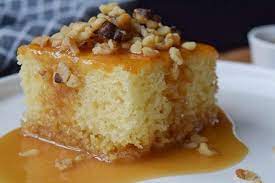
Alright, dessert aficionados, gather ’round because we’re about to embark on a delectable journey into the heart of French Canadian cuisine, with a spotlight on the delightful and heartwarming treat known as pouding chômeur. This dessert isn’t just a sugary delight; it’s a cultural cornerstone of Quebecois gastronomy. So, get ready to learn about its deep-rooted significance, the art of crafting the real deal, and its irreplaceable spot in Quebec’s culinary heritage.
Quebecois Delight: Pouding chômeur’s Cultural Importance

Let’s start by understanding what makes pouding chômeur so uniquely Quebecois. Translated as “unemployed man’s pudding,” pouding chômeur is a dessert that traces its roots to the Great Depression when creative cooks found a way to make something sweet and comforting out of very basic ingredients.
The dish consists of a simple cake batter, often made from flour, sugar, and milk, poured into a pan and topped with a rich, sugary maple syrup sauce. As it bakes, the sauce sinks to the bottom, creating a luscious, gooey layer that perfectly complements the soft cake on top.
But pouding chômeur is more than just a sweet treat. It’s a reflection of Quebec’s history, resilience, and resourcefulness. It embodies the idea that even in tough times, something as simple as dessert can bring joy and comfort to the table. Today, it’s a beloved dessert that continues to hold a special place in Quebecois culture.
The Art of Preparing Authentic Pouding Chômeur
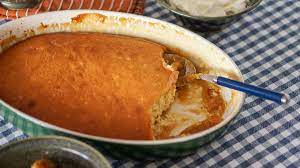
Now, let’s talk about the art of making pouding chômeur, and trust me, it’s a straightforward yet magical process. To create this Quebecois masterpiece, you’ll need some basic pantry staples – flour, sugar, milk, and, of course, pure maple syrup.
First, you prepare the cake batter, which is essentially a blend of flour, sugar, baking powder, and milk. This mixture is poured into a baking dish. Then comes the pièce de résistance – the maple syrup sauce. This heavenly concoction, made from maple syrup, sugar, water, and sometimes a touch of cream, is gently drizzled over the cake batter.
As it bakes, the cake rises to the top while the syrupy goodness pools at the bottom. The result? A dessert that’s the perfect harmony of textures and flavors – soft, slightly crispy on top, and gloriously gooey underneath.
Pouding Chômeur’s Place in Quebec’s Culinary Heritage
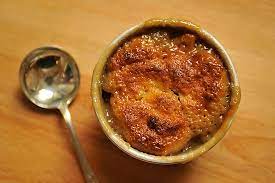
Pouding chômeur isn’t just a dessert; it’s a symbol of Quebec’s culinary heritage. It’s served in homes, restaurants, and sugar shacks across the province, especially during the maple syrup season. And it’s not just a dessert for special occasions; it’s a sweet indulgence enjoyed any day of the week.
But it’s not just about taste; it’s about tradition. Pouding chômeur is a reminder of Quebec’s agricultural roots and its deep connection to the maple trees that dot its landscape. It’s a dish that tells a story, and every bite is a taste of history.
So there you have it, the heartwarming story of pouding chômeur, a French Canadian dessert that’s more than just a sweet treat – it’s a cultural icon. Whether you’re savoring a slice in the heart of Quebec or trying your hand at crafting this culinary gem at home, you’re diving headfirst into the rich and flavorful world of Canada’s cuisines.
Caesar Cocktail: Canada’s Signature Drink
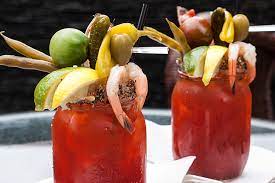
Alright, my fellow cocktail enthusiasts, it’s time to celebrate one of Canada’s most beloved libations – the Caesar cocktail. This iconic Canadian drink isn’t just about sipping; it’s about raising a glass to its proud Canadian origins, mastering the art of crafting a perfect Caesar, and embarking on a journey to discover the best spots across the country to savor this delectable creation.
Raising a Glass to the Caesar Cocktail’s Canadian Origins

Before we dive into the Caesar cocktail’s delicious details, let’s tip our hats to its Canadian roots. This cocktail has a uniquely Canadian story, and it all began in the charming city of Calgary, Alberta, back in 1969.
The Caesar was the brainchild of Walter Chell, a bartender at the Calgary Inn (now known as the Westin Calgary). Inspired by the flavors of Italy, Chell set out to create a refreshing drink that would capture the essence of a Mediterranean meal. The result? A brilliant concoction that blended vodka, Clamato juice (a mix of clam and tomato juices), hot sauce, and various seasonings. It was a flavor explosion like no other.
Chell named his creation the Caesar in honor of the restaurant’s Italian cuisine and, of course, in reference to the Roman Emperor. Little did he know that he was crafting a beverage that would become a Canadian icon.
Crafting a Perfect Caesar Cocktail and Garnishes
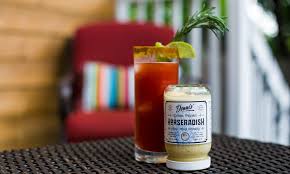
Now, let’s get down to the nitty-gritty of crafting the perfect Caesar cocktail. This delightful concoction is all about balance, flavor, and creativity.
First things first, you need the essentials – vodka, Clamato juice (no substitutes here!), and a dash of hot sauce. But here’s where the fun begins – the garnishes. A Caesar is known for its extravagant toppings. Start with a rimmed glass, dipped in a mixture of salt and spices. Then, add a crispy celery stick for that satisfying crunch. But why stop there? Canadians love to get creative with their garnishes – think pickles, olives, bacon, or even a mini burger slider. The sky’s the limit!
The key to a perfect Caesar is finding your ideal balance of flavors. Some like it spicy with an extra kick of hot sauce, while others prefer a milder, more savory taste. And don’t forget the seasonings – Worcestershire sauce, lime or lemon juice, and a sprinkle of celery salt. Experiment until you find your Caesar sweet spot.
Canada’s Caesar Hotspots: Bars and Restaurants to Explore

If you’re eager to taste Caesars beyond your home bar, fear not. Canada is brimming with Caesar hotspots, from bustling urban cocktail lounges to cozy, hidden gem pubs.
Head to Vancouver, and you’ll find bars that infuse Caesars with Pacific flair, using local ingredients like smoked salmon or fresh seaweed. In Toronto, craft cocktail establishments offer unique twists, like Caesar-inspired martinis or brunch-style Caesars served with towering stacks of garnishes. And in Montreal, you might stumble upon Caesars with a touch of French flair, featuring champagne or a splash of red wine.
But perhaps the most unforgettable Caesar experience is in the heart of Canada’s Rocky Mountains, where mountain lodges and rustic pubs serve up Caesars with breathtaking views. Picture sipping your cocktail while gazing at towering peaks – it’s an experience like no other.
So there you have it, the Caesar cocktail – a Canadian signature drink that’s more than just a beverage; it’s a toast to Canadian ingenuity, flavor, and creativity. Whether you’re crafting your perfect Caesar at home or embarking on a cross-country Caesar tour, you’re diving headfirst into the rich and flavorful world of Canada’s cuisines. Cheers to the Caesar!
Tourtière: A Flavorful Canadian Meat Pie

Alright, food enthusiasts, it’s time to embark on a savory adventure that’ll take us straight to the heart of Canadian cuisine – tourtière. This delectable meat pie isn’t just about savoring its rich flavors; it’s about tracing its journey across Canada’s diverse regions, mastering the art of baking it at home, and uncovering its cherished role in French-Canadian holiday traditions.
The Savory Journey of Tourtière Across Canada’s Regions

Let’s kick things off with a culinary journey that spans from the Atlantic to the Pacific. Tourtière may have its roots in French Canada, but its popularity knows no bounds across the Great White North.
In Quebec, where the tourtière tradition began, you’ll find rich, hearty pies made with a mixture of ground pork, veal, and aromatic spices like cinnamon, cloves, and allspice. These pies are often enjoyed during holiday feasts and family gatherings, where they take center stage.
Head to New Brunswick, and you’ll discover a tourtière twist featuring a blend of ground pork and potatoes, encased in a flaky pastry shell. It’s comfort food at its finest.
Venture into the Prairies, and you’ll encounter tourtières made with a fusion of meats, including pork, beef, and even game meat like venison. Each region adds its unique touch, creating a tapestry of flavors that reflect Canada cuisines diverse culinary landscape.
Baking Tourtière at Home: A Step-by-Step Guide
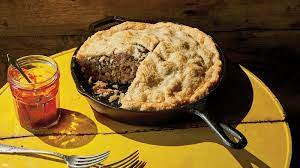
Now, let’s roll up our sleeves and delve into the art of baking tourtière at home. This is where you get to infuse your kitchen with the savory aromas of this Canadian food classic.
First, you’ll need a flaky pastry crust. You can make your own or opt for a store-bought version – no judgment here! Next, prepare your filling, combining your choice of meats with a medley of spices. The key to a fantastic tourtière is getting those spices just right, so don’t be shy with the cinnamon and cloves.
Once your pastry crust and filling are ready, it’s time to assemble your pie. Line your pie dish with the bottom pastry layer, add your flavorful meat mixture, and cover it with a top pastry layer. Make it your own by adding creative designs or patterns to the top crust.
As your tourtière bakes in the oven, your kitchen will be filled with irresistible aromas that will have everyone eagerly awaiting the grand reveal. When it’s golden brown and bubbling, your tourtière is ready to be savored.
Tourtière’s Role in French-Canadian Holiday Traditions

Lastly, let’s explore the heartwarming role of tourtière in French-Canadian holiday traditions. This savory pie isn’t just a dish; it’s a symbol of togetherness and celebration.
In Quebec, tourtière is a staple of Réveillon, the traditional Christmas Eve feast. Families gather around the table, sharing stories and laughter as they enjoy slice after slice of this delicious pie. It’s a moment of warmth and connection during the holiday season.
But tourtière isn’t confined to Christmas. It’s a year-round favorite, making appearances at weddings, birthdays, and community gatherings. It’s a reminder of the enduring ties that bind families and communities together in Quebec and beyond.
So there you have it, the savory tale of tourtière, a Canadian meat pie that’s more than just a dish; it’s a journey through Canada’s culinary diversity, a delicious adventure in your own kitchen, and a treasured tradition that brings people together. Whether you’re savoring it in Quebec or mastering the art of baking it at home, tourtière is a flavorful gem in the crown of Canada cuisines.
Game Meat in Canada: A Wild Culinary Adventure

Alright, folks, get ready for a wild culinary ride as we dive deep into Canada’s rugged terrain and explore the delectable world of game meat. It’s not just about savoring these flavors; it’s about unveiling Canada’s wild side, discovering where to embark on a game meat hunting and dining adventure, and indulging in game meat recipes that will leave your taste buds yearning for more.
Unveiling Canada’s Wild Side: A Guide to Game Meats
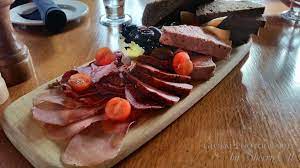
Canada’s vast wilderness isn’t just home to breathtaking landscapes; it’s a treasure trove of game meats that have been part of Indigenous and Canadian cuisine for centuries. From the dense forests of British Columbia to the vast expanses of the Yukon, you’ll find an array of game meats that reflect the country’s rich biodiversity.
Moose, deer, and caribou are staples in many regions, known for their lean and flavorful meat. Meanwhile, in the northern territories, you might encounter game meats like muskox or Arctic hare, each with its unique taste and texture.
Game meats are more than just a source of sustenance; they’re a connection to Canada’s natural heritage and a testament to the skill of hunters who navigate the wilderness to bring these delicious treasures to our tables.
Where to Embark on a Game Meat Hunting and Dining Adventure

Now, if you’re eager to embark on your own game meat adventure, Canada offers a plethora of opportunities. From guided hunting trips in the pristine wilderness to cozy lodges that serve up game meat delicacies, there’s something for every level of adventurer.
Consider a journey to the Yukon, where you can join experienced guides on a moose or caribou hunt. Or venture to Newfoundland and Labrador for a chance to bag some of the finest wild game, all while taking in breathtaking coastal landscapes.
But hunting isn’t the only way to savor game meats. Across Canada, you’ll find restaurants and eateries that specialize in serving these unique flavors. Whether it’s a rustic lodge in the Rockies or a cozy bistro in Quebec City, you’ll have the chance to savor game meats expertly prepared by talented chefs.
Game Meat Recipes for the Adventurous Canadian Cook
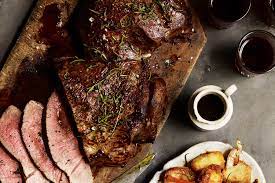
For those who prefer to create culinary magic in their own kitchens, game meat recipes are a fantastic way to embrace Canada’s wild side. Whether you’re a seasoned chef or a novice in the kitchen, there are plenty of recipes to suit your taste and skill level.
Consider whipping up a hearty venison stew, seasoned with herbs and simmered to perfection. Or try your hand at a succulent caribou roast, complemented by a savory berry sauce. And let’s not forget about the classic moose burger, a Canadian favorite that’s both juicy and flavorful.
The beauty of cooking with game meats is that you’re not just preparing a meal; you’re continuing a culinary tradition that has been passed down through generations. It’s a way to connect with the land, the wildlife, and the flavors of Canada.
So there you have it, a wild culinary adventure through the heart of Canada, where game meats take center stage. Whether you’re unveiling Canada’s wild side, embarking on a game meat hunting and dining adventure, or experimenting with game meat recipes in your own kitchen, you’re in for a flavorful journey through Canada cuisines. So, sharpen your knives and get ready to savor the wild!
Read – Foodie’s Guide to Fun & Must-Have New York City Eats
Persian Rolls: Toronto’s Sweet Secret

Hold onto your sweet tooth, folks, because we’re about to uncover one of Toronto’s most beloved pastries – the Persian roll. It’s not just about indulging in these sweet delights; it’s about tracing the evolution of the Persian roll from bakery to home kitchens and embarking on a quest to find Toronto’s best Persian roll bakeries.
Persian Rolls: Toronto’s Beloved Pastry

Now, you might be wondering, what exactly is a Persian roll, and why is it so cherished in Toronto? Well, imagine a fluffy, cinnamon-infused pastry, generously coated in a sweet and tangy raspberry glaze, and often crowned with a sprinkle of chopped pecans. It’s a mouthwatering masterpiece that has captured the hearts (and taste buds) of Torontonians for generations.
The story of the Persian roll’s arrival in Toronto is a bit of a sweet mystery. Some say it was brought to the city by Armenian bakers who had their roots in Iran, while others believe it was a local creation inspired by Persian flavors. Regardless of its origin, one thing is clear – Torontonians have a deep affection for this delectable pastry.
It’s not just about the taste; it’s about the memories attached to it. Many Torontonians fondly recall enjoying Persian rolls at family gatherings, local bakeries, or as a special treat after school. It’s a pastry that’s as much a part of the city’s fabric as its skyline.
The Evolution of the Persian Roll: From Bakery to Home

In recent years, the Persian roll has seen a resurgence in popularity, thanks in part to home bakers who have taken up the challenge of recreating this sweet secret in their own kitchens. Social media platforms are now flooded with homemade Persian roll creations, each one more tempting than the last.
Baking a Persian roll at home is a labor of love, but the results are worth every moment spent in the kitchen. It’s a chance to customize the flavors, experiment with different glazes, and create a pastry that’s uniquely yours. And let’s not forget the satisfaction of pulling a tray of freshly baked Persian rolls from the oven, filling your home with the irresistible aroma of cinnamon and raspberry.
Finding Toronto’s Best Persian Roll Bakeries

While baking Persian rolls at home can be a rewarding endeavor, there’s something special about savoring them from a bakery that has perfected the craft over the years. Toronto is home to a diverse array of bakeries, each with its own take on the Persian roll.
To find Toronto’s best Persian roll bakeries, you’ll need to embark on a sweet adventure. Start by visiting the city’s historic neighborhoods, where you’ll stumble upon bakeries that have been serving Persian rolls for decades. From Kensington Market to Scarborough, these hidden gems are waiting to be discovered.
But the Persian roll scene isn’t limited to traditional bakeries. Toronto’s culinary landscape is ever-evolving, and you’ll find modern twists on this classic pastry in trendy cafes and dessert shops. Whether you prefer a classic Persian roll or one with a contemporary twist, Toronto has something to satisfy your sweet cravings.
So there you have it, the sweet secret of Toronto – Persian rolls. Whether you’re indulging in these beloved pastries, exploring their evolution from bakery to home kitchen, or embarking on a quest to find Toronto’s best Persian roll bakeries, you’re in for a delectable journey through Canada cuisines. So, grab a fork (or your baking supplies) and get ready to savor the sweet side of Toronto!
Acadian Meat Pie: Maritime Comfort Food

Alright, food aficionados, prepare to embark on a savory journey that’ll transport you straight to the heart of Canada’s Maritimes – the Acadian meat pie. This isn’t just about savoring a delicious dish; it’s about uncovering the rich history and traditions behind it, mastering Acadian meat pie recipes that have been passed down through generations, and exploring the diverse flavors of Canada’s eastern coast.
Acadian Traditions and the History of Meat Pie
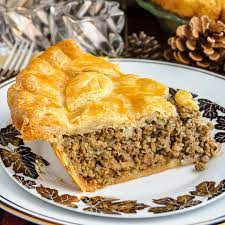
Let’s start by delving into the captivating history and traditions that have shaped the Acadian meat pie. The Acadians, descendants of French settlers in Eastern Canada, have a culinary heritage that’s deeply intertwined with the region’s bounty of seafood, game, and agricultural produce.
The Acadian meat pie, also known as “tourtière,” is a testament to their culinary ingenuity. Traditionally prepared during festive occasions and family gatherings, this hearty pie features a flavorful medley of meats, including ground pork, beef, and sometimes even game meat like rabbit or venison. These meats are combined with aromatic spices, creating a filling that’s rich and savory.
The pie’s crust, tender and flaky, is a work of art in itself, providing the perfect vessel for the delicious meaty interior. It’s often adorned with decorative designs, showcasing the craftsmanship and creativity of Acadian bakers.
Acadian Meat Pie Recipes from the East Coast

Now, for all you aspiring chefs out there, it’s time to roll up your sleeves and explore Acadian meat pie recipes from the East Coast. These recipes have been lovingly passed down from generation to generation, ensuring that the flavors of Acadian cuisine endure.
Start with the basics – a flavorful mix of ground meats, seasoned with a blend of spices like cloves, cinnamon, and allspice. The secret to a fantastic Acadian meat pie is finding the perfect balance of flavors, so don’t be shy when adding those aromatic spices.
Next comes the pastry crust, a crucial component of any pie. You can opt for a traditional lard-based crust for that authentic touch, or go with a buttery alternative if you prefer a lighter pastry.
As you assemble your meat pie, take a moment to appreciate the artistry involved. Some Acadian families have their unique traditions when it comes to creating decorative designs on the crust – it’s a way to make each pie truly their own.
Exploring the Flavors of Canada’s Maritimes

To truly appreciate Acadian meat pie, you have to explore the flavors of Canada’s Maritimes. The East Coast is a region teeming with culinary delights, from freshly caught seafood in Nova Scotia to hearty stews in New Brunswick.
While Acadian meat pie may be the star of the show, don’t miss the opportunity to savor other Maritime dishes. Try a bowl of seafood chowder brimming with scallops, lobster, and mussels, or indulge in a plate of “hodge podge,” a vegetable medley that’s a staple in many Maritime kitchens.
And let’s not forget the mouthwatering desserts. From butter tarts in Ontario to blueberry grunt in Newfoundland, the Maritimes offer a delightful array of sweet treats that perfectly complement the savory goodness of Acadian meat pie.
There you have it, a journey through the heart of Canada’s Maritimes, where Acadian meat pie reigns supreme. Whether you’re exploring the history and traditions behind this comforting dish, crafting your own with cherished recipes, or indulging in the diverse flavors of the East Coast, you’re in for a flavorful adventure through Canada cuisines. So, set your table, invite your loved ones, and get ready to savor the warmth and heritage of Acadian comfort Canadian food.
Jigg’s Dinner: Newfoundland’s Hearty Feast

Alright, fellow food enthusiasts, get ready for a hearty adventure that’ll transport you to the rugged shores of Newfoundland – Jigg’s Dinner. It’s not just about savoring a meal; it’s about experiencing a true taste of Newfoundland, preparing this classic feast for an authentic Canadian cuisine experience, and diving into the rich culinary customs and celebrations of the region.
A Taste of Newfoundland: Jigg’s Dinner Explained
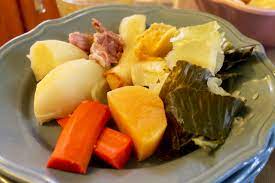
Let’s kick things off with an introduction to Jigg’s Dinner – a beloved Newfoundland tradition that’s as hearty as it is flavorful. Known by various names across the province, including “boiled dinner” or “Sunday dinner,” Jigg’s Dinner is a culinary delight that’s steeped in history and cherished by Newfoundlanders.
At its core, Jigg’s Dinner is a one-pot wonder that features an assortment of ingredients, each contributing to the overall flavor and heartiness of the meal. The star of the show is salted beef, which is soaked to remove excess salt and then simmered to tender perfection. Joining the beef in the pot are an array of root vegetables, including potatoes, carrots, turnips, and cabbage.
Now, here’s where the magic happens. As everything simmers together, the flavors meld, creating a savory broth that infuses each ingredient with a taste of Newfoundland. The result is a wholesome, comforting meal that warms the soul and fills the belly.
Preparing Jigg’s Dinner for a Traditional Canadian Experience
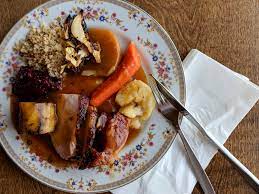
For those looking to embark on a culinary journey, preparing Jigg’s Dinner at home is a must-try. It’s not just about the delicious end result; it’s about embracing Newfoundland’s culinary heritage and traditions.
Begin by sourcing high-quality salted beef, preferably from a local supplier who specializes in traditional Newfoundland ingredients. The beef will need a good soak to remove excess saltiness, so plan accordingly.
Next, assemble your root vegetables – potatoes, carrots, turnips, and cabbage. These humble ingredients may not seem like much on their own, but when they come together in the pot, they create a symphony of flavors.
As you simmer the ingredients, pay attention to the aroma that fills your kitchen. It’s the scent of Newfoundland’s culinary history, a fragrance that transports you to a time when Jigg’s Dinner was a staple of every Newfoundland home.
Newfoundland’s Culinary Customs and Celebrations

Jigg’s Dinner isn’t just a meal; it’s a part of Newfoundland’s cultural fabric. Traditionally enjoyed on Sundays, this feast brings families together, fostering a sense of community and connection.
In Newfoundland, the preparation and sharing of Jigg’s Dinner are often associated with celebrations and special occasions. It’s a meal that’s lovingly prepared for holidays, family gatherings, and community events, where the act of coming together to enjoy a hearty feast is a time-honored tradition.
As you savor Jigg’s Dinner, you’re not just indulging in a meal; you’re becoming a part of Newfoundland’s culinary customs and celebrations, experiencing the warmth and hospitality that define this unique Canadian province.
So there you have it, a taste of Newfoundland that goes beyond the plate – Jigg’s Dinner. Whether you’re exploring the history and traditions behind this hearty feast, preparing it at home for an authentic Canadian experience, or diving into Newfoundland’s culinary customs and celebrations, you’re in for a flavorful journey through Canada cuisines. So, roll up your sleeves, gather your loved ones, and get ready to savor the heart and soul of Newfoundland.
Read – Foodie’s Guide to Charleston, SC
Conclusion
In conclusion, our culinary journey through diverse Canada cuisines has been nothing short of mouthwatering. From the comfort of Jigg’s Dinner in Newfoundland to the rich traditions of Acadian Meat Pie in the Maritimes, and all the way to Toronto’s sweet secret, the Persian Roll, Canadian cuisine culinary landscape is as diverse as its landscape.
These dishes are more than just meals; they are windows into the history, culture, and traditions of the regions they hail from. Each bite tells a story, passed down through generations, and each flavor evokes a sense of home and community.
So, whether you’re a seasoned chef looking to master traditional recipes or a food enthusiast eager to taste your way through Canada’s culinary delights, one thing is clear – Canada cuisines offer a rich tapestry of flavors and traditions waiting to be explored and savored. So, roll up your sleeves, gather your loved ones, and embark on your own culinary adventure through the heart of Canada. It’s a journey you won’t want to miss. Bon appétit!
FAQs
What is the traditional Canadian cuisine?
Traditional Canadian cuisine reflect the country’s diverse cultural influences and regions. Some of the traditional Canadian dishes include:
- Poutine: A Quebecois favorite, made of crispy french fries topped with cheese curds and smothered in rich gravy.
- Tourtière: A flavorful meat pie, especially popular during the holiday season in French-Canadian communities.
- Bannock: A type of Indigenous flatbread, often fried and served with various toppings or as a side dish.
- Butter Tarts: Sweet and gooey tarts filled with a mixture of butter, sugar, and sometimes raisins or pecans.
- Jigg’s Dinner: A hearty Newfoundland dish featuring salted beef, root vegetables, and cabbage boiled together in one pot.
What is the most popular Canadian food?
One of the most popular and iconic Canadian food is poutine. It’s beloved across the country and consists of crispy french fries topped with cheese curds and savory gravy. Poutine has gained international recognition and is often considered a must-try Canadian dish.
What are the best Canada cuisines?
The best Canada cuisines can vary depending on personal taste, but some dishes that are frequently praised and considered among the best include:
- Poutine: Known for its comforting and indulgent flavors.
- Butter Tarts: A beloved Canadian sweet treat.
- Nanaimo Bars: A layered dessert bar that’s both rich and satisfying.
- Tourtière: A flavorful meat pie with regional variations.
- Montreal-style Smoked Meat: Renowned for its unique seasoning and preparation.
What is Canada famous for?
Canada is famous for its stunning natural landscapes, including vast forests, pristine lakes, and breathtaking mountains. It’s also known for its friendly and multicultural society, as well as its contributions to music, literature, and sports. Additionally, Canada is famous for its iconic wildlife, including the majestic moose, the elusive beaver, and the symbol of the country, the maple leaf.
What are 5 traditional foods in Canada?
Traditional foods in Canada reflect the country’s diverse culinary heritage. Here are five traditional Canadian food:
- Bannock: Indigenous flatbread, often fried and served with various toppings.
- Pemmican: A high-energy food made of dried meat, usually mixed with fat and berries.
- Wild Salmon: Fresh and smoked salmon from Canada’s abundant rivers and oceans.
- Fiddleheads: Curled young fern fronds, often used in salads or as a side dish.
- Wild Blueberries: These tiny, sweet berries are a Canadian favorite and used in various desserts and dishes.
What are 3 famous foods in Canada?
Three famous Canadian foods that have gained recognition both within the country and internationally are:
- Poutine: A classic Canadian food made of french fries, cheese curds, and gravy.
- Maple Syrup: Canada is renowned for its high-quality maple syrup, often used as a sweetener for pancakes, waffles, and desserts.
- Beavertails: A popular Canadian pastry that’s deep-fried and typically served with various toppings, such as cinnamon sugar, chocolate, or fruit.

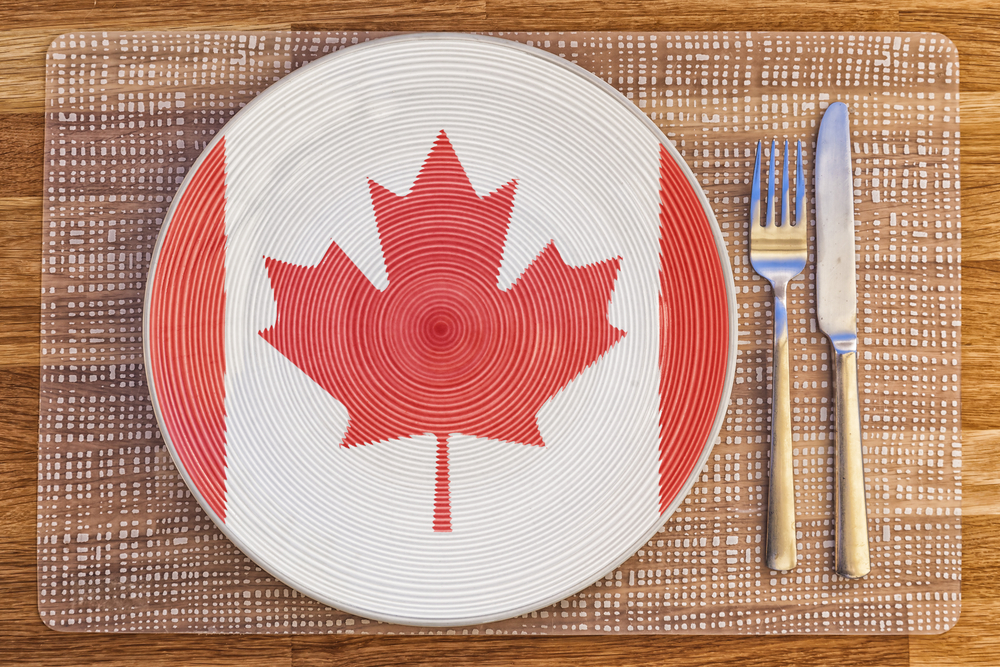



No Comments